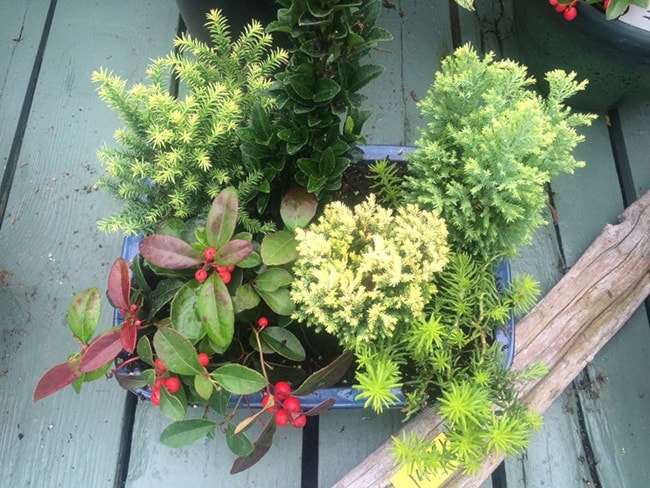In the world of small space gardening, there’s no question that containers rule. In the more cold, weather challenged months of November through March, however, there are not many plants that thrive in pots … or are there?
In zone 5 and higher, I think we’re overlooking the opportunity of using fairly resilient and colourful conifers to create some beautiful container combinations. At this time of year, I would suggest using containers with good cold tolerance. Heavy duty plastic, moulded fibre or resin pots are probably the most tolerant of frost. I particularly love the South American double-walled Crescent pots, which have been used across our country for years now and I am amazed by their cold and frost toughness.
For winter containers, we use a blended nursery soil mixed with screened bark mulch, sawdust, perlite or peat to provide lots of porosity. The soil should retain enough moisture to keep the plants hydrated but also let excess water drain out quickly to minimize frost damage. This is key.
I love the fact that some creative nurseries have looked at conifers from a different perspective and have done two innovative things. First, they have propagated and grown many new varieties, expanding the breadth and depth of the conifer selection by at least tenfold. There is some pretty cool stuff out there. Secondly, they have stopped growing them in the traditional one gallon sized pots and instead, are using smaller sized pots, thereby allowing them to be used in containers or grouped together in ground beds for unique combinations, especially when blended with other plants.
Most of the newer conifers being grown today for small space use are very compact and slow growing. This is a huge advantage for container gardening because they can stay in smaller containers for years. We’ve had some in the same pots for 3 to 4 years, and they look great. All that’s needed is a little pruning and time release fertilizer to keep them in prime condition.
The creative use of conifers comes not only from their new and varied colours but also their unique shapes. Tall, thin plants, like Picea glauca ‘Jeans Dilly’, and more irregular shaped varieties, like Chamaecyparis obtusa ‘Chirimen’, Ilex crenata ‘Dwarf Pagoda’ and Chamaecyparis obtusa ‘Fernspray Gold’ make beautiful focal points. Varieties like Juniperus conferta ‘All Gold’ and Tsuga canadensis ‘Jean Iseli’ have an interesting spill-over affect and Chamaecyparis pisifera ‘Fairy Puff’ and Chamaecyparis obtusa ‘Butter Ball’ add a softening touch. It is important to remember ericas and callunas are technically conifers and the colourful foliaged varieties add that little bit of zip. I like blending them together to get that ‘certain look’. I also love adding bits of driftwood or lichen laden branches to create a particular theme.
Speaking of designing with a theme in mind, fairy gardening is here to stay and miniature conifers, stones and tiny garden tools, chairs and tables etc., help carry out the theme nicely.
Even though most container conifers are slow growing, they need to be trimmed and can be kept not only small but, come spring and summer, can also be trained into unusual shapes. A few uniquely shaped sempervirens, tiny broadleaved plants, like mini euonymus, and small evergreen perennials added to the mix of conifers is a nice touch as well.
The many new varieties of conifers provide all sorts of exciting combination opportunities and remember: there are no rules against creativity. Adding in driftwood, small contorted willow branches, colourful stems of twig dogwoods and lichen laden branches really adds to the look.
